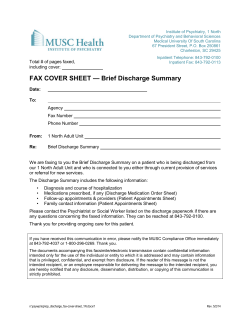
Acute Myocardial Infarction Team Capital Health January 31, 2006
Acute Myocardial Infarction Team Capital Health January 31, 2006 Elizabeth Hodgson & Paula Holt • Implementation Challenges • Mobilizing the team: busy people, full schedules • Resources for data collection: ICONS data, documentation procedures and tools • Implementation Challenges • Education strategy: Cardiology, Cath Lab, Emerg, EMTs • Engaging ED: patient flow, documentation and time factors Chest Pain Flow Through QEII ED Pt arrives at ED with C/Os of Chest Pain Triage Available? NO Pt sits outside triage on bench until Triage Staff available to do assessment Pt arrives via ambulance with CP Yes Triage staff does assessment of pt to determine if CP may be cardiac in nature and CTAS given Pt placed in WR to await Registration. While waiting for bed ECG arranged to be done by TS. Once ECG done it is stamped and given to an EDP to read. If abnormal last ECG pulled for comparison. EDP decides if changes present. If yes pt moved into dept. if no then pt to await further assessment Pt waits until Liaison Nurse/ Room is available. This may cause a small delay in getting ECG. Once ECG done it is stamped and given to an EDP to read. No Chest pain Cardiac? Liaison Nurse/ Room Available? NO Triage Available Yes Yes No CN gets Hx of call from Paramedic and EKG. Does assessment of pt and decides if appropriate for stretcher or WR TS call CN for Bed availability Bed Available? No Pt waits on ambulance stretcher until bed available Yes Pt placed in available stretcher and Nursing staff notified for further assessment and tests Yes Pt given Priority in EDIS for EDP to assess pt. If pt condition deemed critical then EDP paged overhead to do an immediatie assessment Liaison nurse does in-depth assessment of pt.LN does ECG,Bloodwork, & CXR. LN decides pt is Cardiac and contacts CN for bed placement. No bed available then LN stays with pt until a bed is available. If condition deemed critical CN informed and placement within dept. arranged Pt consulted to Cardiology Cardiology resident makes decision on disposition of pt. depending upon findings EDP does assessment. Decides if critical intervention needed and/or consultation to cardiology Improvement Model What are we trying to accomplish? How will we know that a change is an improvement? What changes can we make that will result in improvement? Act Plan Study Do AMI PDSAs • Discharge Summary Form – new document developed • Smoking Cessation – “tool-kit” development to help nurses approach patients, provide teaching • ED times – patient flow studied, early ECG in triage …………………..2 examples 1. make changes Test again make changes Test discharge changes on 6.2 Test again 2. make changes Test timings in ER AMI Intervention Measures 100.0% 90.0% % of Patients Receiving Intervention 80.0% 70.0% 60.0% 50.0% 40.0% 30.0% 20.0% 10.0% 0.0% Baseline Goal Aspirin at Discharge Beta Blocker at Discharge PCI w ithin 90 min Thrombolytic Admin < 30 min ACE or ARB at Discharge Smoking Cessation "Perfect Care" 93.6% 90.8% 33.3% 44.4% 90.9% 22% 48.3% 90% 90% 90% 85% 85% 100% 95% Team Approach • Core Team • Discharge components Team – – – – Aspirin at discharge ACE/ARB at discharge Beta Blocker ate discharge Smoking cessation • Admission components Team – Aspirin within 24 hours – Door to needle 30 mins – Door to PCI 90 mins Remaining Challenges • Documentation/ data collection • Ongoing education (staff changes etc) • Spread (DGH, Hants, Cobequid)
© Copyright 2025





















